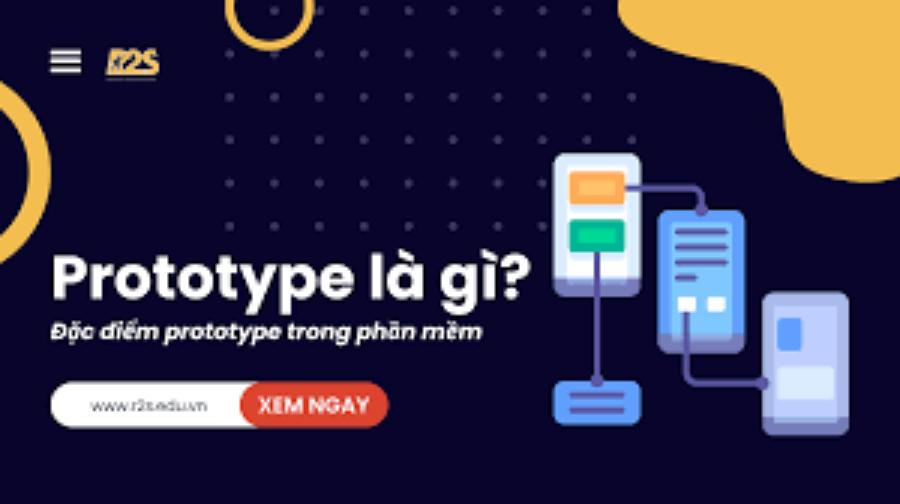Best Selling Products
What is Prototype? The Importance of Prototype in UI/UX Design
Nội dung
- 1. What is Prototype?
- 2. The importance of Prototype in UI/UX design
- 2.1. Prototype helps test and improve user experience
- 2.2. Prototypes help communicate ideas clearly
- 2.3. Prototype helps identify necessary features
- 3. The Process of Creating an Effective Prototype
- 3.1. Step 1: Analyze requirements and determine goals
- 3.2. Step 2: Sketch out initial ideas (Wireframe)
- 3.3. Step 3: Build Prototype
- 3.4. Step 4: Test and collect feedback
- 3.5. Step 5: Improve and perfect the Prototype
- 3.6. Step 6: Confirm Prototype with Stakeholders
- 4. Benefits of Using Prototype in UI/UX Design
- 4.1. Save Time and Money
- 4.2. Increase User Interaction
- 4.3. Improve Product Quality
- 5. Using Prototype in UI/UX Design Projects
- 5.1. Prototype During Ideation Phase
- 5.2. Prototype During User Testing Phase
- 5.3. Prototype During Ideation Phase
- 6. Conclusion
Prototype is an important element in UI/UX design, helping to enhance user experience and optimize the product development process. Discover the role of Prototype and the process of creating an effective Prototype in this article.

Prototype plays an extremely important role in UI/UX design, helping designers test ideas, improve user experience and save development time. Creating an effective Prototype not only requires skills and creativity, but also requires a clear and reasonable process. In the following article, Sadesign will introduce in detail the importance of Prototype in UI/UX design and the process of creating a complete Prototype, bringing high efficiency to the product development process.
1. What is Prototype?
A prototype, also known as a test model, is a model or prototype of a product designed to test and test ideas before developing a complete version. In UI/UX design, a prototype is not simply an interface design but also a tool that helps designers test features, user interactions, and evaluate user feedback visually.
(1).jpg)
Unlike wireframes, which only outline the basic elements of an interface, prototypes allow for the simulation of the actual features of the product, including the ability to interact between parts of the interface. This gives designers a clearer view of how users will use the product and from there make necessary adjustments.
2. The importance of Prototype in UI/UX design
In user interface (UI) and user experience (UX) design, Prototype is an important tool that helps designers and product developers communicate ideas in a visual and understandable way. Prototype, also known as prototype, is the first simulation of a product or interface. It is not a complete product, but it can almost completely reproduce the main functions and interactions of the future product.
Prototypes not only help designers visualize ideas, but also help stakeholders better understand how the product will work in practice. A good prototype can save time, reduce risks, and avoid mistakes during development.
2.1. Prototype helps test and improve user experience
One of the major benefits of using Prototypes in UI/UX design is the ability to test hypotheses about the user experience before entering the development phase. By using Prototypes, the design team can identify issues with the interface, features, or interactions at an early stage. This can even save costs, as errors are detected before being implemented into the actual product.
Testing the prototype also helps designers better understand the needs and desires of users, thereby making appropriate adjustments. A complete prototype can provide valuable feedback from users, helping to create a product that is easy to use and meets the right needs.
2.2. Prototypes help communicate ideas clearly
With a prototype, designers can not only explain their ideas in words but also present them through a realistic interactive model. This is especially important when working with clients or stakeholders who do not have design expertise. A prototype makes it easy for them to visualize the final product and give specific feedback on what needs to be improved. This increases the ability to communicate ideas, reduces misunderstandings, and increases team efficiency.
2.3. Prototype helps identify necessary features
When building a prototype, designers must decide which features to include in the first version of the product. This forces them to carefully consider what is most important to the user and eliminate what is unnecessary. This helps to reduce redundant features and focus on what really brings value to the user.
3. The Process of Creating an Effective Prototype
.jpg)
To have a complete and effective Prototype, designers need to follow a clear and logical process. This process helps ensure that the Prototype meets the requirements of functionality, user experience, and feasibility when implemented into the actual product. Below are the important steps in the process of creating an effective Prototype.
3.1. Step 1: Analyze requirements and determine goals
Before starting to design a prototype, it is important to analyze the project requirements. Designers need to understand the product's goals, target users, and required features. Defining clear goals will help guide the design process and ensure that the prototype meets the user experience requirements.
3.2. Step 2: Sketch out initial ideas (Wireframe)
Sketching out initial ideas is the next step in the prototyping process. Designers use wireframes to show the basic structure of the product. This phase focuses on arranging the main elements of the interface without worrying too much about details or colors. The goal is to create a clear interface framework that helps shape how users will interact with the product.
3.3. Step 3: Build Prototype
Once the wireframe is in place, the designer will move on to building a prototype. This step includes interface elements such as colors, fonts, images, and interactive components. Depending on the complexity of the product, the prototype can be a simple mockup or a full-fledged functional mockup. Using design tools such as Sketch, Figma, or Adobe XD will make this process quick and efficient.
3.4. Step 4: Test and collect feedback
Once the Prototype is complete, the next step is to test it with real users or stakeholders to gather feedback. This testing can be done through user testing sessions, workshops, or in-person meetings. Through this, the design team will receive valuable feedback to adjust and perfect the Prototype.
3.5. Step 5: Improve and perfect the Prototype
Based on the feedback received, the design team will refine the Prototype to address issues and optimize the user experience. This process may include changing the interface structure, adding new features, or tweaking details to make the product more complete. An effective Prototype needs to be flexible and able to change to meet real-world needs.
3.6. Step 6: Confirm Prototype with Stakeholders
Finally, once the Prototype has been refined and finalized, the design team will conduct validation with stakeholders to ensure that all elements have been met as intended. This is an important step to ensure that the Prototype meets the original goals and will transition smoothly into the actual product.
4. Benefits of Using Prototype in UI/UX Design
.jpg)
Using prototypes in UI/UX design offers many benefits, from improving workflow to optimizing the final product. Here are some of the key benefits:
4.1. Save Time and Money
By testing design ideas through prototypes, designers can spot potential issues early. This reduces the number of large revisions required once the product is complete, saving time and money during development.
4.2. Increase User Interaction
Prototyping allows designers to visually test the interface's interactivity. This allows users to realistically experience the product and provide feedback on interface elements such as layout, color, and feature placement.
4.3. Improve Product Quality
By testing and inspecting prototypes, designers can identify elements that are difficult or inconvenient for users. This feedback can be used to refine and improve the product, resulting in a higher quality final product.
5. Using Prototype in UI/UX Design Projects
.jpg)
Prototypes can be applied in many different stages of the UI/UX design process. Here are some common applications of prototypes in design projects.
5.1. Prototype During Ideation Phase
At the beginning of a project, prototypes help designers quickly sketch out ideas and test which ones are most feasible and easy to implement. These simple prototypes help the design team quickly identify major problems with the initial idea.
5.2. Prototype During User Testing Phase
One of the important uses of prototypes is in testing the usability of a product with real users. Designers can use prototypes to conduct user testing sessions, collect feedback, and make appropriate adjustments.
5.3. Prototype During Ideation Phase
Prototypes also play an important role in communicating design ideas to stakeholders, including clients, managers, and the development team. With prototypes, stakeholders can visualize the product more clearly and provide accurate feedback.
6. Conclusion
Prototyping plays a vital role in UI/UX design, not only helping to test and improve the user experience but also helping to communicate ideas and identify necessary features for the product. The process of creating an effective prototype requires continuous analysis, design, testing and improvement to ensure that the final product meets the needs of users and stakeholders.
For designers, mastering the Prototype creation process and understanding its importance will help improve product quality, save time and costs throughout the development process. Prototypes are not only a tool for product development, but also the key to creating excellent user experiences.












































